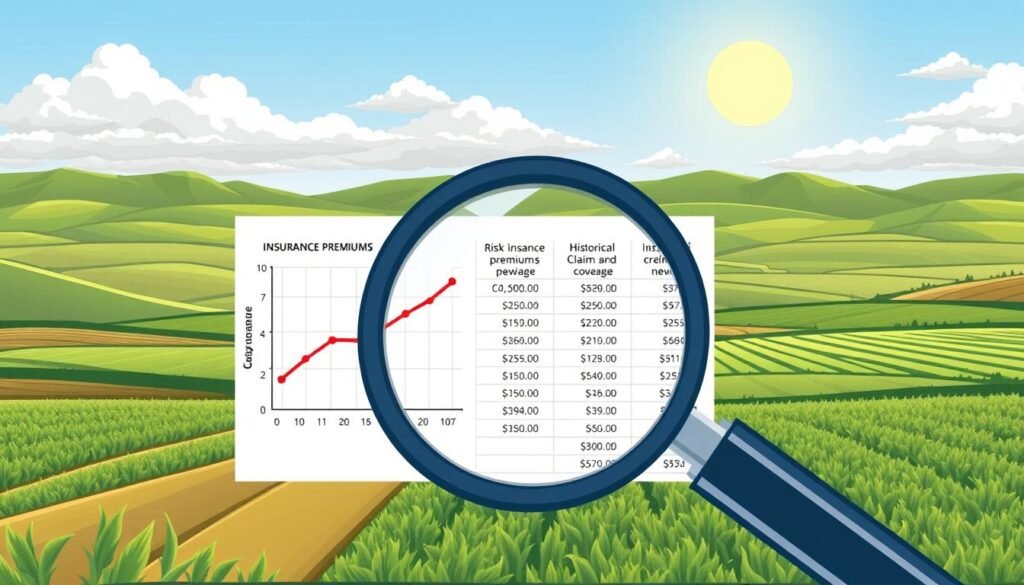Crop insurance and risk management
Did you know over 290 million U.S. acres are covered by crop insurance every year? Weather disasters, market changes, and higher input costs make farming risky. This guide shows how to protect your farm’s future.
Crop insurance and risk management are key for American farmers since 1938. The Federal Crop Insurance Program now covers 134 commodities on 293 million acres. Yet, many farmers still lack full coverage. Managing agricultural risks is more than just insurance—it’s a way to survive in a changing world.
Key Takeaways
- Whole-Farm Revenue Protection (WFRP) insures up to $8.5 million in revenue across multiple crops.
- In Iowa, 94% of corn and soybean acres are covered by federal crop insurance.
- The Noninsured Crop Assistance Program (NAP) offers disaster aid for specialty crops like orchards and vineyards.
- The Risk Management Agency (RMA) partners with private insurers to deliver 85% of U.S. crop insurance programs.
- Farmers like Bill Mason of Maryland credit crop insurance with stabilizing finances during market crashes and droughts.
This guide explains how policies like Revenue Protection, Livestock Gross Margin (LGM), and Dairy Revenue Protection (DRP) help with today’s farming risks. Find out why 9 out of 10 corn growers use these tools and how you can too.
Understanding Agricultural Risk in Today’s Farming Landscape
Farming today requires a sharp eye on risks that can hurt profits. Weather extremes cause over 69% of crop losses, with drought and heatwaves leading to 43.7% of claims since 2000. As indemnity payments grow 19.6% each year, farmers must adopt agricultural risk management strategies to stay strong. A detailed farm risk assessment uncovers weaknesses like climate changes and market shifts, needing specific solutions.
Weather-Related Risks and Their Impact on Crop Production
Weather extremes lead to most loss reports. Droughts and high temperatures caused 43.7% of claims since 2000, while too much moisture led to 25.6%. USDA data shows indemnities increasing 19.6% yearly, showing worsening climate trends. Farmers in the Midwest face long dry spells, while the South deals with flooding that harms roots.
Satellite-based crop monitoring helps track conditions, but crop insurance and risk management are crucial for recovery.
Market Volatility and Price Fluctuations
Global markets bring daily uncertainties. Trade disputes and speculation can wipe out profits quickly. Soybean prices fell 30% in 2023 due to export bans. USDA’s Risk Management Agency offers tools like Revenue Protection policies to stabilize income.
Farmers using these strategies can set price floors, protecting against sudden value drops in commodities.
Operational and Human Resource Challenges
Hidden risks exist beyond the fields. Equipment breakdowns, labor shortages, and regulatory changes can stop operations. A broken combine during harvest costs more than repair fees—it delays sales and strains cash flow. A strong farm risk assessment addresses:
- Equipment maintenance schedules
- Contingency labor plans
- Regulatory compliance updates
IOT sensors and AI tools now monitor machinery health, while partnerships with agricultural universities provide training to reduce workforce gaps.
The Fundamentals of Crop Insurance and Risk Management
Crop insurance and risk management are key for farmers facing unpredictable weather. Today, 75% of U.S. farms are in federal programs. These programs mix government help with private advice to guard against losses.
Crop insurance acts as a financial safety net. It helps when crops fail or prices fall. This lets farmers bounce back and plan for the next season.
The USDA’s Risk Management Agency (RMA) works with agricultural insurance providers. They create policies for local risks like droughts or frost. It’s important for farmers to know a few key terms:
- Premium subsidies can cut costs by up to 60%
- Actual Production History (APH) sets coverage levels
- Indemnity payments kick in when losses hit a certain point
Studies by Ahsan et al. (1982, 1995) highlight how subsidies encourage more farmers to join. Programs like SCO and WFRP fill coverage gaps. Even small farms can get basic protection through NAP, thanks to the RMA.
Learning these basics helps farmers manage risks better. Later, we’ll dive into specific policies and strategies. The aim is to turn these basics into plans that protect farms from unexpected problems.
Types of Crop Insurance Available to American Farmers
American farmers face many risks. Choosing the right crop insurance policy options is key. There are federal-backed programs and specialized add-ons to help with weather, market, and operational challenges. Looking at crop insurance quotes helps find the best fit for each farm.
Multiple Peril Crop Insurance (MPCI)
MPCI is at the heart of federal crop insurance. It covers losses from drought, floods, insects, and freeze. Farmers can choose coverage from 50% to 75% of expected yields.
Enrollment deadlines are strict. Payouts depend on farm-specific yield data. Since 2000, MPCI’s insured acreage has tripled to 494 million acres. It protects against disasters like the 2022 droughts, which caused 43.7% of indemnity payouts.
Crop-Hail Insurance
Private crop-hail policies protect against localized storms not covered by MPCI. These flexible crop insurance coverage options can be bought anytime during growing seasons. Hail damage often hits in isolated areas, making this add-on crucial for specific risks.
Revenue Protection Insurance
Revenue Protection shields against yield drops and price drops. These policies made up 69% of total liability in 2022. If corn prices fall or yields shrink, payouts cover the loss.
This dual coverage helps with modern market volatility challenges.
Yield Protection Coverage
Yield Protection focuses on production losses. Farmers choose coverage levels (50–85% of historical yields). Payouts are made when yields fall below chosen thresholds.
This option ignores price changes but simplifies cost calculations. Specialty crops like fruits or vegetables often use this option.
Comparing crop insurance quotes helps balance protection costs with risk tolerance. Use historical data and RMA guidelines to align coverage with farm-specific risks. Tailoring options to individual needs ensures maximum resilience against unpredictable conditions.
Federal Crop Insurance Programs: USDA and RMA Initiatives
The USDA’s Risk Management Agency (RMA) and the Federal Crop Insurance Corporation (FCIC) are key players in federal crop insurance. They work together with agricultural insurance providers and farmers. This partnership is supported by the government to keep farming stable. Since 2022, new programs like Whole-Farm Revenue Protection (WFRP) and Micro Farm have opened up more areas for farmers. In 2026, over 48 new counties were added.
How the System Works Together
- FCIC provides reinsurance and premium subsidies, totaling $11.98B in 2022.
- Private insurers sell policies under RMA guidelines, ensuring crop insurance policy options like Controlled Environment coverage for plant diseases.
- Producers in 17 states gain access to quarantines and contamination coverage starting in 2024.
Key Benefits for Farmers
Subsidies can cut costs by up to 62%. WFRP covers up to $17M in revenue. The Micro Farm program is affordable for farms making under $350,000. Since 2021, RMA has spent $13M on education, partnering with groups like the Rural South Institute.
Getting Started: Steps to Apply
Eligible producers need to work with crop insurance specialists to:
- Review policy terms for organic crops or controlled environments.
- Submit production history and revenue records by March 4 annual deadlines.
- Select standalone coverage or pair with Nursery Value Select (NVS) options.
Deadlines vary by state—check with local providers by May 1, 2025, for full 2026 coverage.
Conducting a Comprehensive Farm Risk Assessment
A detailed farm risk assessment is key to managing risks in agriculture. Begin by making a list of all your assets. This includes land, equipment, livestock, and stored crops. Knowing their value helps protect what’s important to you.
Then, look at past yield data to find trends. For instance, if droughts hurt corn yields in 2020 and 2022, focus on farm risk mitigation for water-dependent crops. Use checklists to check:
- Weather vulnerability of specific fields
- Past pest outbreaks and their impact
- Equipment failure history
Don’t forget about your farm’s financial health. Look at cash flow gaps, debt levels, and emergency funds. The USDA’s Farm Financial Statements can help with this. Remember, 70% of farmers who do regular assessments cut down on losses by spotting risks early.
Lastly, write down your findings in a clear report. Share it with insurance agents to get the right coverage. NY FarmNet offers free templates to make this easier. A good assessment turns uncertainty into steps you can take, making sure your strategy fits your farm’s needs.
Developing a Custom Risk Management Strategy for Your Farm
Every farm has its own set of challenges. A custom agricultural risk management plan helps turn these challenges into steps you can take. First, list the risks that could hurt your profits. Then, sort them by how big the impact could be and how likely it is to happen.
Use USDA climate maps and yield data to spot patterns. These patterns help guide your crop insurance and risk management choices.
- Identifying Priority Risks: Use a risk matrix to rank threats. Weather, market changes, and input costs are often at the top. Score risks on a 1-10 scale for both probability and impact. Start with the highest scores, like long droughts or pest outbreaks.
- Setting Risk Tolerance Levels: Look at your balance sheets and cash flow. Farms with a lot of debt might want more coverage. For example, a livestock farm with fixed loans might choose higher coverage than a farm with many crops.
- Creating a Multi-Year Plan: Make 3-5 year plans using tools like Compeer’s Optimum analytics. Start with insuring key crops in Year 1. Add futures contracts in Year 2, and climate adaptation in Year 3.
Only 30% of farmers use farm risk mitigation tools like ECO/SCO coverage fully. Regular checks with agents keep plans up-to-date with policy changes and market shifts. Staying proactive helps your strategy keep up with changes like new frost dates or pest resistance.
Start by checking your current protections. Use RMA guidelines to find gaps. Small changes now can make a big difference in facing future challenges.
How to Select the Right Crop Insurance Policy for Your Operation
Choosing the right crop insurance policy options means matching coverage to your farm’s risks. Start by listing your main threats, like weather, market changes, or production issues. Look at crop insurance coverage options like Yield Protection (YP), Revenue Protection (RP), or Area Risk Protection (ARPI). Each is made for different situations.
| Policy Type | Coverage Focus | Key Features |
|---|---|---|
| Yield Protection (YP) | Production losses | Covers yield drops vs. APH; no price fluctuations |
| Revenue Protection (RP) | Yield + price changes | Guarantees revenue using harvest prices; protects against price drops |
| Area Risk Protection (ARPI) | County-level losses | Pays if county-wide yields fall below a threshold |
When looking at crop insurance quotes, compare premiums and deductibles. Higher coverage levels (50-85% of APH) cost more but offer better protection. For instance, choosing 75% YP coverage over 50% means paying more but losing less. Use USDA’s Risk Management Agency tools to see how payouts change with different loss percentages.
Most policies rely on historical yield data. Farmers need accurate records of past harvests for the best coverage. New producers might get higher coverage based on county averages. Always check how prevented planting claims or disaster years affect your APH.
- Compare unit structures: Enterprise units group crops by type, while basic units treat each field separately
- Shop for crop insurance quotes from USDA-approved agents to balance cost and coverage
- Review APH data annually to adjust coverage levels as yields improve or planting patterns change
Work with agents to see how each crop insurance policy option works under different conditions. This ensures your plan protects your farm well without costing too much.
Working with Crop Insurance Specialists and Agents
Finding the right crop insurance specialists or agricultural insurance providers is crucial. They help match complex policies with your farm’s specific needs. Look for agents who know your area’s challenges, like drought or pests, and keep up with USDA rules.
- Ask candidates about experience with organic farming or niche crops.
- Verify if they use tools like the RMA Agent Locator to find certified providers.
- Check if they assist with written agreements for crops not listed in standard policies.
Good agents are more than just salespeople. They look at your farm’s history, suggest extra coverage for new crops, and explain crop insurance quotes that fit your budget. They also review your coverage each year to make sure it matches your farm’s growth or changes in the market.
During bad weather, they help adjust your policy and guide you through claims. When comparing crop insurance quotes, choose agents who explain deductible options and deadlines clearly. Farm Credit’s specialists, for example, offer both policy knowledge and local insights.
Stay away from generic agents. Instead, find those who know your county’s soil and weather history. A reliable agent will also help you meet enrollment deadlines and find new subsidy programs.
Cost-Benefit Analysis: Maximizing Insurance Value While Controlling Expenses
Farmers have to make tough choices about coverage costs and protection. Federal subsidies and smart policy choices can help lower costs without losing safety nets. Let’s look at how to make the most of your investment.

Premium Subsidy Opportunities have grown with government support. Since 2014, the Risk Management Agency has added 300+ new crop insurance policy options. Now, subsidies cover up to 59% of premiums for revenue plans, up from 41.7% before 2000.
Tools like Frontier Farm Credit’s Optimum platform help find gaps. One Iowa farm missed $50k in coverage due to poor policy structuring. Avoid this by reviewing your crop insurance coverage options with providers like Frontier.
- Federal subsidies totaled $11.98 billion in 2022 for agricultural insurance providers like RMA.
- Revenue insurance now covers 90% of farmers due to lower out-of-pocket costs.
Tax Implications are important: premiums are deductible, but indemnities may affect taxable income. Keep track of payments for audits.
Calculating ROI starts with historical yield data. Compare private vs. public costs: private price insurance costs $100/acre vs. $15 extra for government revenue plans. Use subsidy tables to align unit structures (basic, optional, enterprise) with your farm’s needs. Shifting to fixed-dollar subsidies could save $2B yearly by reducing demand for high-cost plans.
Optimize your strategy by reviewing policies annually. Frontier Farm Credit’s free reviews help spot oversights. Prioritize crop insurance coverage options that align with your farm’s risks and budgets.
Beyond Insurance: Complementary Risk Mitigation Strategies
Weather and market changes are big threats to farm profits. Since 2000, drought and heat caused 43.7% of claims. Excess moisture was 25.6%. To manage risks better, farmers should use crop insurance and other strategies.
Crop Diversification Techniques
By growing different crops, farmers can avoid big losses. Rotating crops and growing multiple crops at once helps. Cover crops also improve soil health and don’t affect insurance under the 2018 Farm Bill. For example, Midwest farms mixing corn with soybeans and small grains can reduce yield loss by 30%.
Some techniques include:
- Rotating crops every 2-3 years to disrupt pest cycles
- Integrate high-value crops like organic vegetables into traditional commodity systems
- Use USDA’s Risk Management Agency (RMA) data to select drought-resistant varieties
Weather Technology and Forecasting Tools
Tools like soil sensors and satellite imagery help farmers make better decisions. They can adjust irrigation and get early warnings about drought. Using these tools can help farmers rely less on insurance payouts.
- Soil sensors track moisture levels to prevent over-irrigation
- Drought prediction tools like NOAA’s Climate Prediction Center
- Mobile apps like Climate FieldView for planting timing insights
Marketing Strategies to Reduce Price Risk
Price changes affect 84% of farms with revenue protection policies. Forward contracts and storage can help keep income steady. For example, storing grain until prices are higher can save up to 20% of losses.
- Lock in prices via futures contracts with commodity brokers
- Use USDA’s MyFarmPlan tool for harvest timing decisions
- Direct marketing through CSAs or farmers’ markets reduces middleman risks
Using crop insurance and these strategies together makes farms more resilient. Farms that diversify, use technology, and market smartly can reduce losses by up to 40%, USDA studies show. These methods also support regenerative farming while keeping insurance options open.
Navigating the Claims Process Successfully
When disaster hits, knowing how to handle crop insurance claims is crucial. Start by reporting damage within 72 hours. Never wait more than 15 days after the insurance period ends. Timely action is key to getting compensation from crop insurance specialists and providers.
- Document everything: Take photos, keep field notes, and save receipts to prove losses. Detailed records help strengthen your claims under your chosen crop insurance coverage options.
- File promptly: Send in your paperwork through your agricultural insurance provider on time. Waiting too long can lead to denial.
- Work with adjusters: Cooperate fully during loss assessments. Adjusters use satellite imagery and field inspections to figure out indemnities.
Issues like unclear policy terms or missing forms can slow down payouts. Check your policy’s deductible and coverage limits with your agent before filing. If there are disputes over damage assessments, ask for clarification from your crop insurance specialists right away.
After approval, payments usually come within 30 days. Keep copies of all your correspondence and final settlement documents. Use this experience to adjust your crop insurance coverage options. Consider adding drought or pest protections to better fit your farm’s needs.
Remember: Clear communication with your provider and thorough preparation turn claims into recovery tools. Stay proactive to avoid common pitfalls and ensure fair compensation.
Real-World Success Stories: How Effective Risk Management Saved Farms
Real stories show how farm risk mitigation works. They highlight the power of crop insurance and risk management strategies. Farmers have turned crises into chances for growth.
In 2022, Emily Thompson’s Indiana corn farm hit a hard drought. Her agricultural risk management plan included revenue protection policies. The insurance payout helped her invest in drip irrigation, boosting yields by 30% the next year.
“Insurance wasn’t just a backup—it was a lifeline,” she says. USDA data shows such cases avoid over $1.75 billion in losses annually through proactive coverage.
Marco Reyes in California faced wildfires that damaged crops and equipment. His comprehensive policy covered 85% of losses, letting him rebuild. “Without this, we’d have gone under,” he shared.
Advanced tech like aerial imaging verified damage quickly, speeding up claims.
- Key Takeaway 1: GIS tools and sensors now predict risks, reducing uninsured losses.
- Key Takeaway 2: Combining insurance with tech like irrigation cuts long-term financial risks.
Bill Mason of Maryland adds, “Insurance kept our farm afloat during low-price years. It’s not just about disasters—it’s about staying in business.” These stories prove that smart crop insurance and risk management lets farmers innovate instead of fold when crises hit.
Emerging Trends in Agricultural Insurance and Risk Technology
Modern agricultural risk management is changing fast with new tech. Farmers are using satellite imagery and AI to improve crop insurance and risk management. For example, sensors and drones help gather field data for better policy pricing and claims.
Over 80% of U.S. crops depend on federal programs. But, new options like parametric insurance offer quick payouts when certain conditions are met, like rainfall levels.
- Parametric policies cut red tape by paying out automatically when weather or market triggers occur.
- Satellite and AI tools predict risks, helping agricultural insurance providers design tailored coverage.
- Blockchain tracks claims securely, reducing fraud and delays.
- Whole-farm revenue protection now covers up to 85% of income, blending with tech-based analytics.
- Climate models now factor in extreme weather trends to update risk assessments.
Climate change is making insurers update their models for more disasters. Tools like real-time weather alerts and carbon tracking help farmers get better insurance terms. As tech keeps improving, crop insurance and risk management will focus on sharing data and sustainable practices. Farmers should check out these tools to stay on top of changing conditions.
Common Mistakes Farmers Make with Crop Insurance and How to Avoid Them
Avoid costly errors by understanding these frequent oversights. Crop insurance policy options require careful selection, but many farmers miss key steps. Here’s how to stay compliant:
Underinsuring High-Value Crops
- Specialty crops like berries or tree fruits need tailored coverage. Compare crop insurance quotes to match their higher value.
- Failure to adjust coverage when expanding operations leaves gaps. Review policies annually with crop insurance specialists.
Missing Critical Enrollment Deadlines
- Enrollment for crop insurance policy options has strict dates. Late applications risk reduced coverage.
- File loss reports within 72 hours of damage. Delayed claims can lead to partial or full denial.
Poor Record-Keeping Practices
- Keep precise records of planting dates, acreage, and harvest yields. Errors here skew indemnity calculations.
- Document all crop damage with photos and invoices to support claims. Missing proof delays payouts.
Stay proactive: Use digital tools to track deadlines, cross-reference FSNs, and maintain organized records. Partnering with crop insurance specialists ensures your crop insurance quotes align with your farm’s unique risks.
Conclusion: Securing Your Farm’s Future Through Proactive Risk Management
Proactive risk management is key for a farm to thrive. Today, 75% of U.S. farmers use crop insurance, showing its importance. But, success goes beyond just picking a policy. It needs constant review and changes.
Begin with a farm risk assessment to find weak spots. Look at weather, market changes, and operational issues. Then, choose crop insurance that fits your farm to guard against drought or pests.
Modern farming mixes insurance with diverse crops and technology. Use real-time weather tracking and keep financial reserves. Diversifying crops and using GPS can also help.
Remember, managing risks is an ongoing process. Update your insurance yearly and try new things like stress-resistant seeds. These steps help you face both sudden disasters and long-term changes.
More than 90% of insured farms using certain insurance saw less financial stress in extreme weather. By using these strategies, farmers can handle crises and grow. Start by getting a risk assessment and looking at insurance options.
A strong plan doesn’t just prevent loss. It lets you invest in new equipment or sustainable practices. With the right approach, risk management can lead to lasting growth in agriculture.
Source Links
- Horizon Farm Credit – https://www.horizonfc.com/services/crop-insurance-risk-management
- No title found – https://www.extension.iastate.edu/agdm/crops/html/a1-58.html
- Comprehensive Guide: Navigating Crop Insurance Policies and Agricultural Risk Management Strategies in the United States – – https://farmonaut.com/usa/comprehensive-guide-navigating-crop-insurance-policies-and-agricultural-risk-management-strategies-in-the-united-states/
- Mastering Agricultural Risk Management: Expert Insights on Crop Insurance and Farm Succession Planning in North Dakota – – https://farmonaut.com/usa/mastering-agricultural-risk-management-expert-insights-on-crop-insurance-and-farm-succession-planning-in-north-dakota/
- Cultivating Stability: The Significance of Crop Insurance for Farmers and Agricultural Lenders – https://www.agcountry.com/en/News/2024/January/Insurance
- Crop Insurance as a Tool for Price and Yield Risk Management – https://link.springer.com/chapter/10.1007/978-1-4757-3583-3_20
- Risk Management – Crop Insurance at a Glance – http://www.ers.usda.gov/topics/farm-practices-management/risk-management/crop-insurance-at-a-glance
- Crop Insurance 101: The Basics – https://www.fb.org/market-intel/crop-insurance-101-the-basics
- Crop Insurance for Urban Farmers – https://rma.usda.gov/about-crop-insurance/urban-farmers
- Breaking Down Barriers to Crop Insurance – https://www.farmers.gov/blog/breaking-down-barriers-crop-insurance
- USDA Expands, Improves Crop Insurance Program for Producers Using Controlled Environments – https://www.rma.usda.gov/news-events/news/2025/washington-dc/usda-expands-improves-crop-insurance-program-producers-using
- Risk Management Strategies for Agribusinesses – https://www.insurancethoughtleadership.com/risk-management/risk-management-strategies-agribusinesses
- Effective Farm Risk Management Plan for Every Farming Stage – https://agtech.folio3.com/blogs/effective-farm-risk-management-plan/
- Microsoft Word – RM for Small Farms5.doc – https://www.ctahr.hawaii.edu/agrisk/pdfs/gnrlRMA/managingRiskSmallFarm.pdf
- 10 Strategies for Navigating Crop Insurance Coverage – https://www.compeer.com/articles/2023/november-2023/10-strategies-for-navigating-crop-insurance-in-2024
- Building a Risk Management Plan – https://legacy.rma.usda.gov/pubs/1998/barmp/rmp.pdf
- Insurance Plans | Risk Management Agency – https://rma.usda.gov/about-crop-insurance/managing-farm-risk/insurance-plans
- Factors to Consider when Selecting a Crop Insurance Policy – http://extension.msstate.edu/publications/factors-consider-when-selecting-crop-insurance-policy
- Tips to Help Maximize Your Relationship with Your Crop Insurance Agent – https://momentum.ag/tips-to-help-maximize-your-relationship-with-your-crop-insurance-agent/
- The Role of Expert Agents in Choosing the Right Risk Management Plan – https://momentum.ag/the-role-of-expert-agents-in-choosing-the-right-risk-management-plan/
- Crop Insurance – https://mosaorganic.org/education-resources/crop-insurance
- Why Crop Insurance Review Matters: Greater Risks, Greater Options – https://www.frontierfarmcredit.com/resources/learning-center/why-crop-insurance-review-matters-greater-risks-greater-options
- Center for Agricultural and Rural Development – https://www.card.iastate.edu/products/policy-briefs/display/?n=1154
- Enhanced Coverage Option (ECO) | RMA – https://old.rma.usda.gov/en/Fact-Sheets/National-Fact-Sheets/Enhanced-Coverage-Option
- The Case for Crop Insurance Reform – https://conservationfinancenetwork.org/2020/04/08/the-case-for-crop-insurance-reform
- How to go beyond traditional climate risk management to tackle amplified exposures more effectively – https://www.wtwco.com/en-nz/insights/2025/01/how-to-go-beyond-traditional-climate-risk-management-to-tackle-amplified-exposures
- Navigating Crop Insurance Claims in Texas and Beyond – https://www.vosslawfirm.com/blog/navigating-crop-insurance-claims-in-texas-and-beyond.cfm
- Understand the Crop Insurance Process in Four Easy Steps – https://www.proag.com/blog/crop-insurance/basics-of-crop-insurance-the-process-in-four-easy-steps/
- Revolutionizing Crop Insurance: How GIS and Machine Learning Combat Fraud in USA Agriculture – – https://farmonaut.com/usa/revolutionizing-crop-insurance-how-gis-and-machine-learning-combat-fraud-in-usa-agriculture/
- Choosing Between Crop Insurance and Comprehensive Farm Insurance – https://thefarminginsider.com/crop-insurance-vs-comprehensive-farm-insurance/
- How Crop Insurance Helps to Minimize 5 Key Risks Facing American Farmers – https://riskandinsurance.com/how-crop-insurance-minimizes-5-risks-facing-farmers/
- 2023 Crop Insurance Guide: Essential Risk Management Tools for Farmers in the United States – – https://farmonaut.com/usa/2023-crop-insurance-guide-essential-risk-management-tools-for-farmers-in-the-united-states/
- Agricultural Insurance Market Report 2024-2030: A $40+ Billion Industry Transformed by Satellite Imagery and Data Analytics Offerings – https://www.globenewswire.com/news-release/2024/10/30/2971709/28124/en/Agricultural-Insurance-Market-Report-2024-2030-A-40-Billion-Industry-Transformed-by-Satellite-Imagery-and-Data-Analytics-Offerings.html
- Avoid These 5 Common Crop Insurance Mistakes – https://www.vosslawfirm.com/library/common-crop-insurance-mistakes-farmers-make-when-buying-policies.cfm
- Common Crop Insurance Mistakes That Can Affect Claims – https://amsins.com/crop-insurance-mistakes/
- Risk Management in Farming – https://thefarminginsider.com/farming-risk-management/
- Agricultural Insurance Explained: Coverage and Benefits – https://blog.ehab.co/agricultural-insurance-explained-coverage-and-benefits








